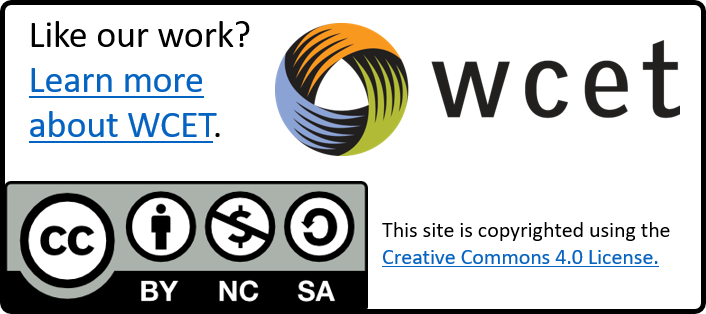In our last dual enrollment post, we discussed the various types of dual enrollment courses, impact of these courses, who’s taking and offering these courses, and the pros and cons of dual enrollment. This week we’re looking at some promising practices suggested by experts in the field, how technology impacts these types of courses, what may be included in Higher Education Reauthorization legislation related to this topic, and the future of dual enrollment.
Promising Ideas in Dual Enrollment Practices
Do you offer dual enrollment courses or are you hoping to start? Several of these come from my conversations with dual enrollment experts like Cynthia Grua, from the Office of the Commissioner for Higher Education for the Utah System of Higher Education and Adam Lowe, Executive Director of the National Alliance of Concurrent Enrollment Partnerships (NACEP). Here are some promising practices when providing these courses:
- What will be the required instructor qualifications for your program?

- Some accrediting agencies require certain instructor qualifications for dual enrollment courses. See the Guidelines from the Higher Learning Commission.
- Check out this great example from our 2018 Leadership Summit from Coconino Community College: their model for dual enrollment instruction addresses the accreditation challenges by maintaining the college instructor as the instructor of record, who guides the local high school instructor to augment what the main instructor presents and support students in the local classroom.
- Consider scheduling, travel time, parking, and other factors when determining the class delivery location (on college or high school campus).
- Student Requirements:
- What requirements should students meet to take these classes? Will the high school set the requirements, or will your partner college set them?
- Ensure the requirements are spelled out clearly for student reference.
- Schools should also consider what help is available to help students meet these initial requirements.
- Student Support Services
- Students need support for preparing, enrolling, and completing these more advanced courses. Support may include, but is not limited to:
- Academic counseling and advisement,
- Tutoring,
- Study skills workshops,
- Student success courses (Purnell, 2014).
- Library resources.
Technology Impacts on Dual Enrollment
There are a few ways technology affects or enables dual enrollment, from my conversation with Adam Lowe, Executive Director of NACEP.
Technology Ensures Access
Technology ensures that more schools can offer dual enrollment programs for their students. There are schools that would not have the opportunity to offer dual enrollment without distance delivered courses. Rural schools are often far removed from a college or university campus, so it’s hard for students to get to the campus or for faculty to the high school. These same schools may have fewer teachers available or with the skills/credentials to teach these types of classes.
Connecting Instructors
There’s also an opportunity to use technology to enhance the relationship between high school instructors and on-campus faculty.
The local, high school instructors receive assistance, mentorship, and ongoing support from the faculty member, often using technologies such as video conferencing, learning management systems, cloud storage, etc. to do so.

Enrollment and Registration
Technology will have a huge impact on the student registration and enrollment process for dual enrollment courses. In the past, and in some cases, currently, registration was done with pen and paper. Slowly, this is moving to electronic and online registration. Customization is needed on the electronic platforms to register students at the high school in courses that are technically offered by the college or university.
Dual Enrollment in the Higher Education Reauthorization Act Proposals
One of the major topics I discussed with Adam Lowe, Executive Director of NACEP, was potential elements related to dual enrollment in bills reauthorizing the Higher Education Act. As Russ Poulin, WCET, reminds me, we probably will not see significant action or reauthorization this year (and perhaps for a few years), it is still interesting to view what is being proposed as those ideas sometimes appear in other legislation or actions by the Department. Here are a few of those elements:
Funding for teacher training and graduate programs to ensure qualified teacher candidates
One of the challenges to continuing dual enrollment programs is a shortage of qualified teachers. There’s fewer teachers who qualify due to decreased public investment in teaching, turnover, decreased incentives for teachers to get master’s degrees, etc.
Innovation Grants
There are limited opportunities for federal grants to invest in innovative programs, but there is also strong interest in innovation right now. How do we create more opportunities for institutions to try new things and scale their innovative ideas? There’s potential for dual enrollment to have a big impact on student success with this type of support.
Pell Grants
The largest investment by the federal government in higher education is through Pell grants (and other federal grants). High school students, even those taking dual enrollment courses through a college or university, are ineligible for Pell grants. These students can attend college for free or at least at a reduced rate if they wait a few years. They are penalized if they try to take a course during high school. There isn’t a consistent way to support low income students during high school.
Future of Dual Enrollment
What’s the future of dual enrollment courses? If we answer some of the outstanding questions asked in today’s post (related to instructor qualifications and funding), will these types of courses continue to be offered? Here are several interesting considerations for the future of these types of course:
Evaluation of Dual Enrollment
 Despite the growth of dual enrollment in recent years spurred at least in part by significant state investment, there has been relatively little evaluation about the impact of these programs. Demaree Michelau, Vice President, Policy Analysis and Research with the Western Interstate Commission for Higher Education (WICHE), advised me that “There have been more than a few times when institutions and states have initiated dual and concurrent enrollment programs with the idea that just because they would expand access they would succeed. Policymakers are now asking us about how to define success and what metrics can be used to measure it. We are working with states, such as Idaho, to help them understand what impacts their investments are having on student outcomes and if the programs are achieving their intended goals. Policymakers also want to know if these programs are reducing postsecondary attainment gaps or exacerbating them.” Illustrating this point, Dr. Michelau cited a University of Texas System comprehensive research study released this month that examines how dual credit programs affect graduation rates and student debt and looks at the consequences of the exponential enrollment growth in dual credit programs, among other factors.
Despite the growth of dual enrollment in recent years spurred at least in part by significant state investment, there has been relatively little evaluation about the impact of these programs. Demaree Michelau, Vice President, Policy Analysis and Research with the Western Interstate Commission for Higher Education (WICHE), advised me that “There have been more than a few times when institutions and states have initiated dual and concurrent enrollment programs with the idea that just because they would expand access they would succeed. Policymakers are now asking us about how to define success and what metrics can be used to measure it. We are working with states, such as Idaho, to help them understand what impacts their investments are having on student outcomes and if the programs are achieving their intended goals. Policymakers also want to know if these programs are reducing postsecondary attainment gaps or exacerbating them.” Illustrating this point, Dr. Michelau cited a University of Texas System comprehensive research study released this month that examines how dual credit programs affect graduation rates and student debt and looks at the consequences of the exponential enrollment growth in dual credit programs, among other factors.
First Year Experiences
What lessons can we learn from first year experience courses and programs in colleges and that may help dual enrollment students? The first-year experiences should be offered to ensure students are successful in these more advanced courses.
Finances
How can/should dual enrollment be financed? What can states do to fund dual enrollment? Jennifer Zinth with the Education Commission of the States cited this as one of the trending topics in dual and concurrent enrollment in 2017. Tuition for these courses varies widely by state (Zinth, 2017). Will higher education reauthorization include the use of Pell grants?
Supporting Students
How can high schools and colleges support the more “reluctant learners” who don’t see college as an option for themselves? How do instructors and advisors entice students to enroll in dual enrollment course their senior year versus taking easy course for their last year (or leaving early)? What’s in it for them?
OER
What impact will Open Educational Resources (OER) have on dual enrollment courses? This is connected to the financial questions that still surround dual enrollment. Tanya Spilovoy, WCET’s Director of Open Policy, says that “Open educational resources would remove obstacles for students who are considering taking dual enrollment courses. Students are used to free textbooks in high school, and many families can’t afford the college textbooks required for dual enrollment courses. Dual enrollment allows high school students to enroll in college courses, creates pathways to college, and shortens their time to degree completion, but textbook costs are an obstacle (when books aren’t already covered by the dual enrollment program)” (CO Dept of Ed, 2016). In Dr. Spilovoy’s research and report for the Colorado Department of Higher Education OER Council, she recommended that institutions utilize OER in dual enrollment courses to increase access, equity, and inclusion.
According to the Colorado Department of Higher Education and Colorado Department of Education’s Annual Report on Concurrent enrollment 2015-2016 School year, more than 38,000 Colorado high school students take at least one dual enrollment class, which amounts to one-third of all Colorado juniors and seniors. Dual enrollment participation in Colorado by race:
- Asian: 3.1%
- African American: 3.1%
- Hispanic: 22%
- Native American: 0.6%
- White: 54.8%
Instructor Requirements
For these courses to truly impact students, we need more clarification on a major issue facing dual enrollment today: instructor qualifications. The Higher Learning Commission (HLC) update on instructor requirements has to have decreased the numbers of instructors able to teach these courses, which is a loss for students (especially those in more rural school districts). The current requirement is that a high school instructor of dual enrollment classes have a mater’s degree in the topic they are teaching (or at least 18 related graduate credit hours) and Master of Education degrees, which many instructors achieve in order to advance their careers, will not meet the requirement if they are teaching dual enrollment math, science, English, etc.
Equity
When former U.S. Education Department official Dr. Kim Hunter Reed was Executive Director of the Colorado Department of Higher Education, she had a keen interest in dual enrollment. First, she wanted to be sure that everyone (regardless of income, district, race, or location) had access to these courses. Dr. Reed also saw these courses as a path to encourage populations commonly under-represented in higher education to understand that they could succeed in college-level work and to get a head start on their postsecondary career.
These goals were memorialized in the Colorado Commission on Higher Education’s Master Plan: Colorado Rises. The plan set four goals:
- Increase Credential Completion;
- Erase Equity Gaps;
- Improve Student Success;
- Invest in affordability and Innovation.
Based on recommendations in “Open Educational Resources in Colorado” a report commissioned by the Colorado Department of Education, the Colorado Open Educational Resources Council prioritized the funding of projects that “target courses with high enrollment, textbook or materials costs as well as high impact courses such as pathways or concurrent high school enrollment” (CO OER Council, 2017).
Conclusions
I’ve thought a lot about these courses over the past several months. I see the amazing benefits the course experiences can provide our students, but I also some of the kinks that need to be worked out.
My colleagues at WICHE will be co-sponsoring with the University of Texas System and others discussions on these topics and more at a Research and Policy Symposium on Concurrent and Dual Credit Courses in October in Denver. If you’re interested in expanding your knowledge on the topic and participating in great discussions, I think this is the opportunity for you.
Enjoy your day,
Lindsey
 Lindsey Downs
Lindsey Downs
Manager, Communications
WCET – WICHE Cooperative for Educational Technologies
ldowns@wiche.edu
@lindsey0427
References
“Concurrent Enrollment.” Accessed 2018. Colorado Department of Education. Retrieved from https://www.cde.state.co.us/postsecondary/concurrentenrollment
“Concurrent Enrollment” (2018). Step Up Utah. Retrieved February 2018 from https://stepuputah.com/program/concurrent-enrollment/
Colorado Department of Education, (2016). Colorado Department of Higher Education and Colorado Department of Education’s ANNUAL REPORT ON CONCURRENT ENROLLMENT 2015-2016 School Year. Retrieved from http://highered.colorado.gov/Publications/Reports/Enrollment/FY2016/2016_Concurrent_Enrollment_April_2017.pdf
Colorado OER Council, 2017. Open Educational Resources in Colorado. Retrieved from https://highered.colorado.gov/Publications/Reports/legislative/OER/OER_Nov2017.pdf
NACEP, 2018. Fast Facts about Dual and Concurrent Enrollment. National Alliance of Concurrent Enrollment Partnerships. Retrieved February 2018 from http://www.nacep.org/research-policy/fast-facts/
Fink, J., Jenkins, D., and Yanagiura, T. (September 2017). What Happens to Students Who Take Community College “Dual Enrollment” Courses in High School? Community College Research Center. Retrieved from https://ccrc.tc.columbia.edu/media/k2/attachments/what-happens-community-college-dual-enrollment-students.pdf
Institute of Education Sciences. (February 2017). What Works Clearinghouse Intervention Report, Dual Enrollment Programs. Retrieved from https://ies.ed.gov/ncee/wwc/Docs/InterventionReports/wwc_dual_enrollment_022817.pdf
Marken, S., Gray, L., and Lewis, L. (2013). Dual Enrollment Programs and Courses for High School Students at Postsecondary Institutions: 2010–11 (NCES 2013- 002). U.S. Department of Education. Washington, DC: National Center for Education Statistics. Retrieved 2/26/18 from http://nces.ed.gov/pubsearch
Meador, Derrick. (2017, March 18). What is Concurrent Enrollment? Retrieved from https://www.thoughtco.com/what-is-concurrent-enrollment-319425.
Taylor, Jason. (2015, July 17). Accelerating Pathways to College, the (In)Equitable Effects of Community College Dual Credit. Community College Review. Col 43, Issue 4, pp. 355-379. https://doi.org/10.1177%2F0091552115594880
Purnell, R. (2014). A guide to launching and expanding dual enrollment programs for historically underserved students in California. Research and Planning Group for California Community Colleges. https://www.asundergrad.pitt.edu/sites/default/files/DualEnrollmentGuideJune2014.pdf
Zinth, J. (2017). What’s Trending in Dual and Concurrent Enrollment Policy Around the States. Education Commission of the States. MACEP 2017 State Policy Workshop.



 Despite the growth of dual enrollment in recent years spurred at least in part by significant state investment, there has been relatively little evaluation about the impact of these programs. Demaree Michelau, Vice President, Policy Analysis and Research with the Western Interstate Commission for Higher Education (WICHE), advised me that “There have been more than a few times when institutions and states have initiated dual and concurrent enrollment programs with the idea that just because they would expand access they would succeed. Policymakers are now asking us about how to define success and what metrics can be used to measure it. We are working with states, such as Idaho, to help them understand what impacts their investments are having on student outcomes and if the programs are achieving their intended goals. Policymakers also want to know if these programs are reducing postsecondary attainment gaps or exacerbating them.” Illustrating this point, Dr. Michelau cited a
Despite the growth of dual enrollment in recent years spurred at least in part by significant state investment, there has been relatively little evaluation about the impact of these programs. Demaree Michelau, Vice President, Policy Analysis and Research with the Western Interstate Commission for Higher Education (WICHE), advised me that “There have been more than a few times when institutions and states have initiated dual and concurrent enrollment programs with the idea that just because they would expand access they would succeed. Policymakers are now asking us about how to define success and what metrics can be used to measure it. We are working with states, such as Idaho, to help them understand what impacts their investments are having on student outcomes and if the programs are achieving their intended goals. Policymakers also want to know if these programs are reducing postsecondary attainment gaps or exacerbating them.” Illustrating this point, Dr. Michelau cited a  Lindsey Downs
Lindsey Downs